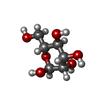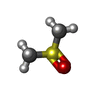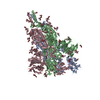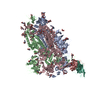[English] 日本語
 Yorodumi
Yorodumi- EMDB-11336: SARS-CoV-2 spike in prefusion state (flexibility analysis, 1-up c... -
+ Open data
Open data
- Basic information
Basic information
| Entry | Database: EMDB / ID: EMD-11336 | ||||||||||||||||||
|---|---|---|---|---|---|---|---|---|---|---|---|---|---|---|---|---|---|---|---|
| Title | SARS-CoV-2 spike in prefusion state (flexibility analysis, 1-up closed conformation) | ||||||||||||||||||
 Map data Map data | |||||||||||||||||||
 Sample Sample |
| ||||||||||||||||||
 Keywords Keywords | Spike / Prefusion / Flexibility / Closed / VIRAL PROTEIN | ||||||||||||||||||
| Function / homology |  Function and homology information Function and homology informationsymbiont-mediated disruption of host tissue / Maturation of spike protein / Translation of Structural Proteins / Virion Assembly and Release / host cell surface / host extracellular space / viral translation / symbiont-mediated-mediated suppression of host tetherin activity / Induction of Cell-Cell Fusion / structural constituent of virion ...symbiont-mediated disruption of host tissue / Maturation of spike protein / Translation of Structural Proteins / Virion Assembly and Release / host cell surface / host extracellular space / viral translation / symbiont-mediated-mediated suppression of host tetherin activity / Induction of Cell-Cell Fusion / structural constituent of virion / membrane fusion / entry receptor-mediated virion attachment to host cell / Attachment and Entry / host cell endoplasmic reticulum-Golgi intermediate compartment membrane / positive regulation of viral entry into host cell / receptor-mediated virion attachment to host cell / host cell surface receptor binding / symbiont-mediated suppression of host innate immune response / receptor ligand activity / endocytosis involved in viral entry into host cell / fusion of virus membrane with host plasma membrane / fusion of virus membrane with host endosome membrane / viral envelope / symbiont entry into host cell / virion attachment to host cell / SARS-CoV-2 activates/modulates innate and adaptive immune responses / host cell plasma membrane / virion membrane / identical protein binding / membrane / plasma membrane Similarity search - Function | ||||||||||||||||||
| Biological species |  | ||||||||||||||||||
| Method | single particle reconstruction / cryo EM / Resolution: 3.1 Å | ||||||||||||||||||
 Authors Authors | Martinez M / Marabini R | ||||||||||||||||||
| Funding support |  Spain, Spain,  United States, 5 items United States, 5 items
| ||||||||||||||||||
 Citation Citation | Journal: bioRxiv / Year: 2020 Title: Continuous flexibility analysis of SARS-CoV-2 Spike prefusion structures. Authors: Roberto Melero / Carlos Oscar S Sorzano / Brent Foster / José-Luis Vilas / Marta Martínez / Roberto Marabini / Erney Ramírez-Aportela / Ruben Sanchez-Garcia / David Herreros / Laura Del ...Authors: Roberto Melero / Carlos Oscar S Sorzano / Brent Foster / José-Luis Vilas / Marta Martínez / Roberto Marabini / Erney Ramírez-Aportela / Ruben Sanchez-Garcia / David Herreros / Laura Del Caño / Patricia Losana / Yunior C Fonseca-Reyna / Pablo Conesa / Daniel Wrapp / Pablo Chacon / Jason S McLellan / Hemant D Tagare / Jose-Maria Carazo /   Abstract: With the help of novel processing workflows and algorithms, we have obtained a better understanding of the flexibility and conformational dynamics of the SARS-CoV-2 spike in the prefusion state. We ...With the help of novel processing workflows and algorithms, we have obtained a better understanding of the flexibility and conformational dynamics of the SARS-CoV-2 spike in the prefusion state. We have re-analyzed previous cryo-EM data combining 3D clustering approaches with ways to explore a continuous flexibility space based on 3D Principal Component Analysis. These advanced analyses revealed a concerted motion involving the receptor-binding domain (RBD), N-terminal domain (NTD), and subdomain 1 and 2 (SD1 & SD2) around the previously characterized 1-RBD-up state, which have been modeled as elastic deformations. We show that in this dataset there are not well-defined, stable, spike conformations, but virtually a continuum of states moving in a concerted fashion. We obtained an improved resolution ensemble map with minimum bias, from which we model by flexible fitting the extremes of the change along the direction of maximal variance. Moreover, a high-resolution structure of a recently described biochemically stabilized form of the spike is shown to greatly reduce the dynamics observed for the wild-type spike. Our results provide new detailed avenues to potentially restrain the spike dynamics for structure-based drug and vaccine design and at the same time give a warning of the potential image processing classification instability of these complicated datasets, having a direct impact on the interpretability of the results. | ||||||||||||||||||
| History |
|
- Structure visualization
Structure visualization
| Movie |
 Movie viewer Movie viewer |
|---|---|
| Structure viewer | EM map:  SurfView SurfView Molmil Molmil Jmol/JSmol Jmol/JSmol |
| Supplemental images |
- Downloads & links
Downloads & links
-EMDB archive
| Map data |  emd_11336.map.gz emd_11336.map.gz | 118.2 MB |  EMDB map data format EMDB map data format | |
|---|---|---|---|---|
| Header (meta data) |  emd-11336-v30.xml emd-11336-v30.xml emd-11336.xml emd-11336.xml | 19.9 KB 19.9 KB | Display Display |  EMDB header EMDB header |
| FSC (resolution estimation) |  emd_11336_fsc.xml emd_11336_fsc.xml | 15.2 KB | Display |  FSC data file FSC data file |
| Images |  emd_11336.png emd_11336.png | 55.5 KB | ||
| Filedesc metadata |  emd-11336.cif.gz emd-11336.cif.gz | 6.9 KB | ||
| Others |  emd_11336_half_map_1.map.gz emd_11336_half_map_1.map.gz emd_11336_half_map_2.map.gz emd_11336_half_map_2.map.gz | 218.3 MB 218.4 MB | ||
| Archive directory |  http://ftp.pdbj.org/pub/emdb/structures/EMD-11336 http://ftp.pdbj.org/pub/emdb/structures/EMD-11336 ftp://ftp.pdbj.org/pub/emdb/structures/EMD-11336 ftp://ftp.pdbj.org/pub/emdb/structures/EMD-11336 | HTTPS FTP |
-Validation report
| Summary document |  emd_11336_validation.pdf.gz emd_11336_validation.pdf.gz | 1 MB | Display |  EMDB validaton report EMDB validaton report |
|---|---|---|---|---|
| Full document |  emd_11336_full_validation.pdf.gz emd_11336_full_validation.pdf.gz | 1 MB | Display | |
| Data in XML |  emd_11336_validation.xml.gz emd_11336_validation.xml.gz | 23.1 KB | Display | |
| Data in CIF |  emd_11336_validation.cif.gz emd_11336_validation.cif.gz | 30.8 KB | Display | |
| Arichive directory |  https://ftp.pdbj.org/pub/emdb/validation_reports/EMD-11336 https://ftp.pdbj.org/pub/emdb/validation_reports/EMD-11336 ftp://ftp.pdbj.org/pub/emdb/validation_reports/EMD-11336 ftp://ftp.pdbj.org/pub/emdb/validation_reports/EMD-11336 | HTTPS FTP |
-Related structure data
| Related structure data |  6zp5MC  6zowC  6zp7C C: citing same article ( M: atomic model generated by this map |
|---|---|
| Similar structure data | |
| EM raw data |  EMPIAR-10516 (Title: Cryo electron microscopy of SARS-CoV-2 spike in prefusion state EMPIAR-10516 (Title: Cryo electron microscopy of SARS-CoV-2 spike in prefusion stateData size: 2.1 TB / Data #1: 2.outputMovies [micrographs - multiframe]) |
- Links
Links
| EMDB pages |  EMDB (EBI/PDBe) / EMDB (EBI/PDBe) /  EMDataResource EMDataResource |
|---|---|
| Related items in Molecule of the Month |
- Map
Map
| File |  Download / File: emd_11336.map.gz / Format: CCP4 / Size: 307.5 MB / Type: IMAGE STORED AS FLOATING POINT NUMBER (4 BYTES) Download / File: emd_11336.map.gz / Format: CCP4 / Size: 307.5 MB / Type: IMAGE STORED AS FLOATING POINT NUMBER (4 BYTES) | ||||||||||||||||||||||||||||||||||||||||||||||||||||||||||||||||||||
|---|---|---|---|---|---|---|---|---|---|---|---|---|---|---|---|---|---|---|---|---|---|---|---|---|---|---|---|---|---|---|---|---|---|---|---|---|---|---|---|---|---|---|---|---|---|---|---|---|---|---|---|---|---|---|---|---|---|---|---|---|---|---|---|---|---|---|---|---|---|
| Projections & slices | Image control
Images are generated by Spider. | ||||||||||||||||||||||||||||||||||||||||||||||||||||||||||||||||||||
| Voxel size | X=Y=Z: 1.047 Å | ||||||||||||||||||||||||||||||||||||||||||||||||||||||||||||||||||||
| Density |
| ||||||||||||||||||||||||||||||||||||||||||||||||||||||||||||||||||||
| Symmetry | Space group: 1 | ||||||||||||||||||||||||||||||||||||||||||||||||||||||||||||||||||||
| Details | EMDB XML:
CCP4 map header:
| ||||||||||||||||||||||||||||||||||||||||||||||||||||||||||||||||||||
-Supplemental data
-Half map: #2
| File | emd_11336_half_map_1.map | ||||||||||||
|---|---|---|---|---|---|---|---|---|---|---|---|---|---|
| Projections & Slices |
| ||||||||||||
| Density Histograms |
-Half map: #1
| File | emd_11336_half_map_2.map | ||||||||||||
|---|---|---|---|---|---|---|---|---|---|---|---|---|---|
| Projections & Slices |
| ||||||||||||
| Density Histograms |
- Sample components
Sample components
-Entire : SARS-CoV-2 spike in prefusion state (flexibility analysis, 1-up c...
| Entire | Name: SARS-CoV-2 spike in prefusion state (flexibility analysis, 1-up closed conformation) |
|---|---|
| Components |
|
-Supramolecule #1: SARS-CoV-2 spike in prefusion state (flexibility analysis, 1-up c...
| Supramolecule | Name: SARS-CoV-2 spike in prefusion state (flexibility analysis, 1-up closed conformation) type: complex / ID: 1 / Parent: 0 / Macromolecule list: #1 |
|---|---|
| Source (natural) | Organism:  |
-Macromolecule #1: Spike glycoprotein
| Macromolecule | Name: Spike glycoprotein / type: protein_or_peptide / ID: 1 / Number of copies: 3 / Enantiomer: LEVO |
|---|---|
| Source (natural) | Organism:  |
| Molecular weight | Theoretical: 142.399375 KDa |
| Recombinant expression | Organism:  Homo sapiens (human) Homo sapiens (human) |
| Sequence | String: MFVFLVLLPL VSSQCVNLTT RTQLPPAYTN SFTRGVYYPD KVFRSSVLHS TQDLFLPFFS NVTWFHAIHV SGTNGTKRFD NPVLPFNDG VYFASTEKSN IIRGWIFGTT LDSKTQSLLI VNNATNVVIK VCEFQFCNDP FLGVYYHKNN KSWMESEFRV Y SSANNCTF ...String: MFVFLVLLPL VSSQCVNLTT RTQLPPAYTN SFTRGVYYPD KVFRSSVLHS TQDLFLPFFS NVTWFHAIHV SGTNGTKRFD NPVLPFNDG VYFASTEKSN IIRGWIFGTT LDSKTQSLLI VNNATNVVIK VCEFQFCNDP FLGVYYHKNN KSWMESEFRV Y SSANNCTF EYVSQPFLMD LEGKQGNFKN LREFVFKNID GYFKIYSKHT PINLVRDLPQ GFSALEPLVD LPIGINITRF QT LLALHRS YLTPGDSSSG WTAGAAAYYV GYLQPRTFLL KYNENGTITD AVDCALDPLS ETKCTLKSFT VEKGIYQTSN FRV QPTESI VRFPNITNLC PFGEVFNATR FASVYAWNRK RISNCVADYS VLYNSASFST FKCYGVSPTK LNDLCFTNVY ADSF VIRGD EVRQIAPGQT GKIADYNYKL PDDFTGCVIA WNSNNLDSKV GGNYNYLYRL FRKSNLKPFE RDISTEIYQA GSTPC NGVE GFNCYFPLQS YGFQPTNGVG YQPYRVVVLS FELLHAPATV CGPKKSTNLV KNKCVNFNFN GLTGTGVLTE SNKKFL PFQ QFGRDIADTT DAVRDPQTLE ILDITPCSFG GVSVITPGTN TSNQVAVLYQ DVNCTEVPVA IHADQLTPTW RVYSTGS NV FQTRAGCLIG AEHVNNSYEC DIPIGAGICA SYQTQTNSPG SASSVASQSI IAYTMSLGAE NSVAYSNNSI AIPTNFTI S VTTEILPVSM TKTSVDCTMY ICGDSTECSN LLLQYGSFCT QLNRALTGIA VEQDKNTQEV FAQVKQIYKT PPIKDFGGF NFSQILPDPS KPSKRSFIED LLFNKVTLAD AGFIKQYGDC LGDIAARDLI CAQKFNGLTV LPPLLTDEMI AQYTSALLAG TITSGWTFG AGAALQIPFA MQMAYRFNGI GVTQNVLYEN QKLIANQFNS AIGKIQDSLS STASALGKLQ DVVNQNAQAL N TLVKQLSS NFGAISSVLN DILSRLDPPE AEVQIDRLIT GRLQSLQTYV TQQLIRAAEI RASANLAATK MSECVLGQSK RV DFCGKGY HLMSFPQSAP HGVVFLHVTY VPAQEKNFTT APAICHDGKA HFPREGVFVS NGTHWFVTQR NFYEPQIITT DNT FVSGNC DVVIGIVNNT VYDPLQPELD SFKEELDKYF KNHTSPDVDL GDISGINASV VNIQKEIDRL NEVAKNLNES LIDL QELGK YEQGSGYIPE APRDGQAYVR KDGEWVLLST FLGRSLEVLF QGPGHHHHHH HHSAWSHPQF EKGGGSGGGG SGGSA WSHP QFEK UniProtKB: Spike glycoprotein |
-Macromolecule #6: 2-acetamido-2-deoxy-beta-D-glucopyranose
| Macromolecule | Name: 2-acetamido-2-deoxy-beta-D-glucopyranose / type: ligand / ID: 6 / Number of copies: 18 / Formula: NAG |
|---|---|
| Molecular weight | Theoretical: 221.208 Da |
| Chemical component information |  ChemComp-NAG: |
-Macromolecule #7: alpha-D-mannopyranose
| Macromolecule | Name: alpha-D-mannopyranose / type: ligand / ID: 7 / Number of copies: 2 / Formula: MAN |
|---|---|
| Molecular weight | Theoretical: 180.156 Da |
| Chemical component information |  ChemComp-MAN: |
-Macromolecule #8: DIMETHYL SULFOXIDE
| Macromolecule | Name: DIMETHYL SULFOXIDE / type: ligand / ID: 8 / Number of copies: 3 / Formula: DMS |
|---|---|
| Molecular weight | Theoretical: 78.133 Da |
| Chemical component information |  ChemComp-DMS: |
-Experimental details
-Structure determination
| Method | cryo EM |
|---|---|
 Processing Processing | single particle reconstruction |
| Aggregation state | particle |
- Sample preparation
Sample preparation
| Buffer | pH: 8 |
|---|---|
| Vitrification | Cryogen name: ETHANE |
- Electron microscopy
Electron microscopy
| Microscope | FEI TITAN KRIOS |
|---|---|
| Image recording | Film or detector model: GATAN K3 (6k x 4k) / Average electron dose: 36.0 e/Å2 |
| Electron beam | Acceleration voltage: 300 kV / Electron source:  FIELD EMISSION GUN FIELD EMISSION GUN |
| Electron optics | Illumination mode: FLOOD BEAM / Imaging mode: BRIGHT FIELD |
| Experimental equipment |  Model: Titan Krios / Image courtesy: FEI Company |
 Movie
Movie Controller
Controller



















 Z (Sec.)
Z (Sec.) Y (Row.)
Y (Row.) X (Col.)
X (Col.)






































